Bjarke Ingels on the New York Dryline: 'We think of it as the love-child of Robert Moses and Jane Jacobs'
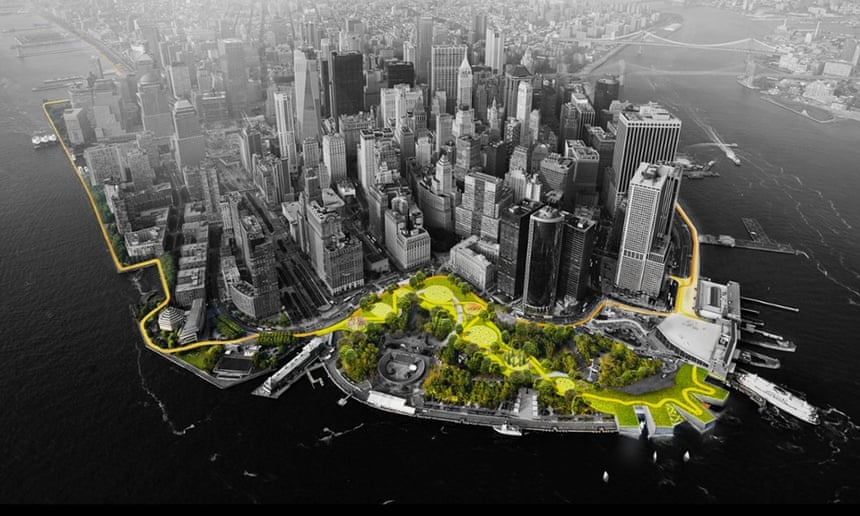 After the High Line park, and the planned underground Lowline, comes the Dryline: an uncompromising seawall cum green space. Photograph: BIG
Oliver Wainwright
After the High Line park, and the planned underground Lowline, comes the Dryline: an uncompromising seawall cum green space. Photograph: BIG
Oliver Wainwright
Monday, 9 March, 2015
Quote:
There aren’t many architects you would believe could hold back seas and save the world from being drowned by Biblical floods. But when you meet Bjarke Ingels, anything seems eminently possible.
At the age of 40, a mere teenager in architectural terms, the sprightly Danish architect has built a career on making unlikely feats appear effortlessly doable, and madcap schemes look perfectly logical. He has summoned mountain-shaped apartment blocks from the suburban flatlands of Copenhagen, designed a waste-to-energy plant down whose sloping rooftop you will be able to ski and proposed a cage-free zoo in which visitors will be held captive while the animals roam free. He’s even convinced Google to build a pastoral utopia beneath an enormous glass tent.
A few blocks from his New York office he is building a giant pyramid of apartments, wrenched askew to limbo beneath the neighbours’ viewing corridors, with a big courtyard scooped out of the middle. Now at its full height, rearing up beside the West Side Highway, it is one of the most arresting buildings Manhattan’s regimented grid has ever seen, as well as one of the most commercially illogical: it tapers up to a tiny point, leaving only a handful of flats at the most lucrative upper levels. The architects can barely believe they found someone brave (or mad) enough to pay for it. Yet once again the cartoonish diagram, of the wilful form generated by the forces acting on the site, has come true.
In the hands of his practice BIG (the Bjarke Ingels Group), which now numbers 220 people between Copenhagen and New York, even chimneys can be turned into wellsprings of creative possibility. In London they want to install a gigantic Tesla coil between the smokestacks of Battersea Power Station, so that an electric bolt may strike on occasion, sending a streak of lightning fizzing across the sky. Back in Denmark, the chimney of their power plant will be the coolest flue around: it is designed to blow smoke rings, puffing 30-metre wide halos towards the heavens. So what’s the trick to selling these harebrained comic-book dreams? There must be more to it than Bjarke’s boyish charm alone.
“I call it bigamy,” says Ingels, sitting in his New York office, where two floors of architects are busy twisting new typologies into shape, while a widescreen TV streams activity of his Copenhagen office doing the same some 4,000 miles away. “Why have one when you can have both? We find that seemingly contradictory things are not always mutually exclusive.”
On a quick dash through the office we see a pair of twirling towers under construction in Miami, a whirlwind of a watch museum planned for Switzerland, a honeycomb block of seaside apartments for the Bahamas, with a swimming pool lapping up to the balustrade of each balcony, and a model of something alarmingly tall in the corner of the office – from which my gaze is quickly averted. “If a factory has to exhaust gas,” says Ingels, distracting me with a video of the power-plant chimney test-run on his phone, like a child showing off his latest app, “then why not transform its emissions into a thing of beauty? If you’re going to do something anyway, then you might as well give it a public benefit as well.”
BIG’s latest conjuring trick awaits in the next room. Hanging on the wall is a plan of Manhattan with a thick green line running around the island’s tip. It gets fatter and thinner as it traces around the coastline, swelling out into an occasional bulge, like a snake curled up after a meal. Then comes the bigamist proposition, told with the seductive spiel of a TED talk. If New York has to build 10 miles of flood defences to protect the city from another Hurricane Sandy, why not conceive the barrier as a brand new waterfront park? Climate security as leisure amenity. You can almost hear the standing ovation and all-American whooping in the background.
|
Quote:
In the city that transformed a rusting railway track into the elysian High Line, and which is planning to turn an underground trolley-bus terminal into the atmospheric Lowline, now comes the latest snappily named linear park: meet the Dryline.
It is a vision as ingenious as it is elementary, a why-didn’t-they-do-it-already no-brainer of a plan. An animation produced by London studio Squint Opera shows the 10-mile long strategy being unrolled like a magic carpet along the waterfront, leaving safe leisure-loving citizens in its wake. With a sprinkling of fairy-dust, the shoreline becomes furnished with undulating berms and protective planting, flip-down baffles and defensive kiosks, promenades and bike paths, bringing pedestrian life worthy of Lisbon or Barcelona to the gritty banks of Manhattan.
“We like to think of it as the love-child of Robert Moses and Jane Jacobs,” says Ingels. It is a project that is at once tyrannical and touchy-feely, as if the bullish highway builder and the people’s urban activist had sat down to draw up a plan over tea: an uncompromising seawall that also wants to give you a hug. “I think they would have agreed on a lot of things if only they had worked together,” Ingels adds cheerfully. “Our project must have Moses’ scale of ambition, but be able to work at the fine-grain scale of the neighbourhoods. It shouldn’t be about the city turning its back on the water, but embracing it and encouraging access. By taking it one conversation at a time, with the principle that everyone can get their fantasy realised, you end up getting there.”
It is the most ambitious product of Rebuild by Design, a $1bn federally-funded programme to restore the northeastern seaboard following the devastation caused by Hurricane Sandy in 2012, introducing new infrastructure to guard against future inundations. Ten schemes were selected to be taken forward from an international competition, addressing everything from new breakwaters along Staten Island’s South Shore, to flood prevention and drainage in Hoboken, New Jersey. BIG was the only team to look at Manhattan itself. “It was a bit like going to a big dance,” says Ingels. “No one picks the prettiest girl because they’re too shy.” His office evidently suffers from no such impediment. Its website is named http://big.dk/ after all.
|
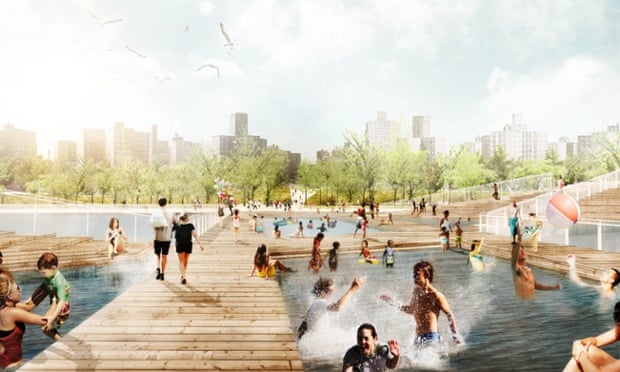 The harbour baths, part of the proposed New York Dryline flood defences. Photograph: BIG
The harbour baths, part of the proposed New York Dryline flood defences. Photograph: BIG
Quote:
Originally called the BIG-U, but recently rebranded so as not to promote one office alone (the team includes 10 other consultants, from engineering to landscape), the Dryline imagines a landscaped buffer stretching all the way from West 57th Street, looping down to the Battery and back up to East 42nd Street, bestowing Manhattan with a protective green cushion. Hurricane Sandy shocked New York into facing up to quite how vulnerable it is – and opened the city’s eyes to the realities of climate change. It provided violent and tangible evidence, if ever it were needed, that extreme weather is here, sea levels are on the rise and that cities must adapt more urgently than ever before. It also changed locals’ perception of the city’s physical geography overnight.
“The storm really made people aware of the geological map of Manhattan,” says Kai-Uwe Bergmann, BIG’s partner in charge of the Dryline project, when we meet across town at the East River Park where basketball courts and soccer pitches lie under a deep layer of ice. To the north, the chimneys of the Con Edison power plant chug wispy white tendrils into the frozen blue sky, from the very plant that exploded during the superstorm, plunging lower Manhattan into darkness and leaving 750,000 residents without power.
“It returned to water everything that had originally been water,” says Bergmann. “Canal St became a canal again and all the reclaimed land was totally submerged, essentially taking the city back to its 1640 coastline.”
The hurricane caused $19bn of damage and saw 305,000 homes harmed or destroyed, many of which were here in the vulnerable Lower East Side, a low-lying, low-income district where rows of public housing blocks sit as modernist “towers in the park”. Only it’s the kind of park that actually means car parking, and swathes of tarmac and concrete did little to alleviate the floodwaters.
As the most vulnerable area – and the district least likely to attract private investment, mostly consisting of New York City Housing Authority blocks – this first section of the Dryline has received $335m from the US Department of Housing and Urban Development to go ahead. The two-mile long stretch focuses on building a “bridging berm”, a snaking green mound that will rise to 15 feet (4.57m), the once-in-a-hundred-years flood level which Sandy almost reached, and provide a landing point for footbridges across the FDR Drive, the roaring six-lane highway that effectively severs residents of the Lower East Side from the waterfront. The existing bridges, which are narrow and intimidatingly caged, will be replaced with open landscaped bridges three times the width, bringing people across to the top of the sloping berm, which will also seclude the new park from traffic noise.
|
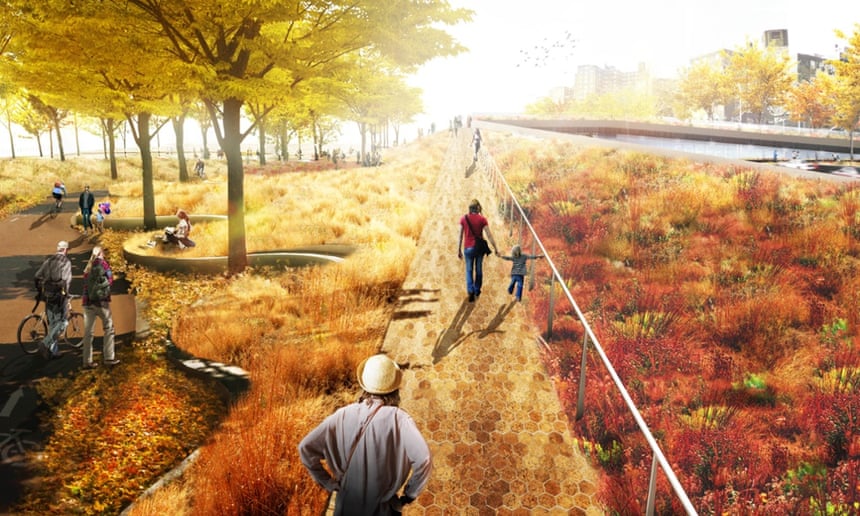 A rendering of the New York Dryline flood defences. Photograph: BIG
A rendering of the New York Dryline flood defences. Photograph: BIG
Quote:
As the berm weaves its way along the highway, it will take on the character of different areas, curving around existing sports pitches, morphing into grandstand seating and providing a level at which the road might be permanently covered over in future. There are plans for fishing piers as well as wild swimming pools in the spirit of Copenhagen’s harbour baths, which came out of one of the first consultation meetings, when an enthusiastic group of East River swimmers turned up.
Further south, beyond the first funded compartment, the Dryline adapts to bring existing infrastructure into action against the rising waters. Between the Brooklyn and Manhattan bridges, it’s proposed that the underside of the elevated highway is kitted out with flip-down panels to form a defensive wall in the event of a storm warning, while providing a decorative soffit above a new public space the rest of the time. A stepped 4ft-high bench snakes its way alongside skate park structures and tai-chi platforms, catering to the large elderly Chinese community. As Ingels puts it: “The beauty of the High Line is that it’s a piece of decommissioned infrastructure that is now enjoyable – but why wait?”
In the third compartment, at the lower tip of Manhattan, a series of pill-shaped pavilions have been designed with sturdy central flood walls and doors that slide out to plug the gaps, forming a continuous vertical barrier, while retaining views through to the river the rest of the time. As the Dryline meets Battery Park, the berm is planned to return, forming a series of grassy knolls that slope down to a potential new multi-fingered waterfront building, like a blocky claw extended to baffle the tides. It is imagined – with a dash of implacable BIG optimism – as a new Maritime Museum, featuring a spectacular “reverse aquarium” from where visitors might observe the rising waters beneath dangling whale skeletons.
As ever with BIG’s bold visions, it can all seem too good to be true, too glib to withstand the battering from both the elements and the public sector bureaucracy now charged with building it. Revisiting their most substantial completed landscape project to date, two years on, brings mixed feelings. The Superkilen park, which weaves its way through one of the most deprived parts of Copenhagen, is still a joyful, well-used strip of surreal undulating mounds, with furniture and play equipment sourced from around the world to reflect the ethnic diversity of the area. But it requires a huge amount of maintenance that the local authority is in no position to keep up, now a scene of flaking paint, broken equipment and the forlorn air of an Expo site left to rot. Whatever gets made in Manhattan will have to be built of sturdier stuff.
Others fear the Dryline will give New Yorkers a false sense of protection, leading the city to become blasé behind its new defences. “The city should be proud of the project,” says Klaus Jacob, an esteemed climate scientist at Columbia University, who predicted the impact of a major storm just a year before Sandy arrived. “Except it has a fixed height. As the sea level rises, you need ever smaller storms to overcome it. It’s exactly New Orleans’ problem during Katrina. People think, ‘We have this Big U, we’re safe.’ But you’re building up risk behind the U until it becomes dysfunctional.”
“I’m not saying it will leak during the first 10 years,” he adds, “but the sea-level rise calculated is out to the 2050s. What about the 2080s? 2100? You just postpone the problem for future generations.”
|
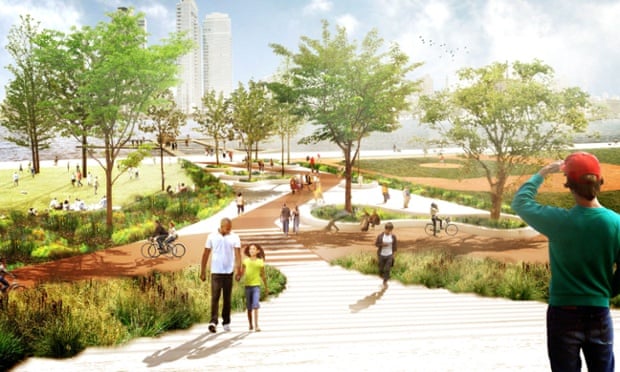 A section of the Dryline’s bridging berm. Photograph: BIG
A section of the Dryline’s bridging berm. Photograph: BIG
Quote:
The arrival of a new green leisure magnet has also sparked fears of gentrification among Lower East Side residents, having seen what effect the High Line has had on the meat-packing district the other side of town. A real estate gold mine wrought in gravel and shrubbery, the planted walkway has attracted over $2bn in private investment since it opened in 2009, seeing local property prices more than double. “It would be terrible if people were against their own interests from this kind of gentrifying fear,” says Ingels, assuring the area in question is protected from such forces, given its designation as New York City public housing.
But concerns have also been raised about detailed development happening behind closed doors, now the general ambition for the Dryline has been accepted and handed over to the city to deliver – with BIG’s team subcontracted to corporate engineering consultancy, AKRF. At a public meeting last autumn, community spokeswoman Damaris Reyes described it as a “slap in the face” that local residents “are not even part of the discussions beyond this public setting”. “We don’t want you to come to us at the 11th hour,” she added. “We need to be involved in the planning process.” A task force has since been set up, says the mayor’s office, to ensure that “all of the appropriate people are at the table”.
The bigger question remains how the rest of the 10-mile green necklace will be funded, and quite what form it will take. Like many of New York’s major parks, it will likely have to rely heavily on private investment. Seventy-five percent of Central Park’s annual operating budget is now covered by private money through the Central Park Conservancy, a privately bankrolled non-profit that, along with the likes of the Battery Park Conservancy and the Friends of Hudson River Park, now does the work of the hollowed-out public sector.
Meanwhile some philanthropists are splashing out on entirely new parks of their own, of a very different kind. Media mogul Barry Diller and his fashion designer wife Diane von Furstenberg, both major donors to the High Line, have recently unveiled their scheme for a magical “pier park” nearby, planned to sprout from the Hudson River atop great toadstool columns. Designed by miracle mushroom maker Thomas Heatherwick, it will cost $170m – compared to the $130m that mayor Bill de Blasio has committed to spend on upgrading 35 parks in poor neighbourhoods across the entire city. Critics suggest the project will be just another playground for tourists and those who can afford lunch in the Meatpacking district.
|
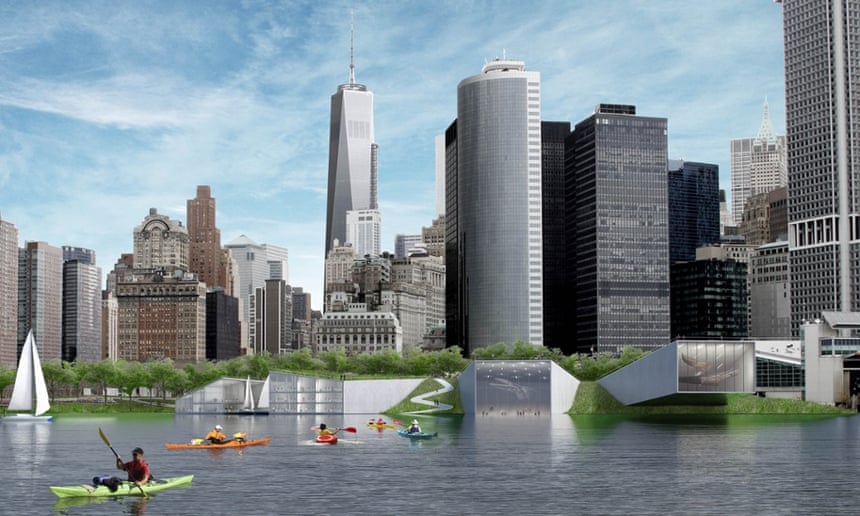 Part of the New York Dryline at Battery Park, featuring a school and ‘reverse aquarium’. Photograph: BIG
Part of the New York Dryline at Battery Park, featuring a school and ‘reverse aquarium’. Photograph: BIG
Quote:
Henk Ovink, the Dutch water management expert who has headed up the Rebuild by Design effort for the last two years, says potential private donors were approached for the first stages of the Dryline in the Lower East Side, with little success.
“We tried to see if they might be interested to help on a more supportive level,” he says. “But they’re not. Simply because there’s no return on investment. There’s a total prohibition on private development in that area.”
For the forthcoming stages, where the Dryline runs into the well-heeled districts along the prow of Manhattan, up to Tribeca and the West Village, BIG is starting to look at what is known, in the US philanthropy trade, as “plaque-able entities”, ie things you can slap a funder’s name on. There are early sketches for artist-designed barriers along the highway’s central reservation and suggestions of what a Jeppe Hein flood wall might look like. There’s a danger that these things are merely more baubles for Diller and Furstenberg’s big-hearted chums, but the ambition seems genuine, in the architects’ eyes at least, while mindful of needing to play the American funding game. Perhaps the billionaire benefactors will be persuaded to stump up cash for useful infrastructure after all. Barry’s Berm has a certain ring to it.
But for now, all efforts are focused on making the first publicly funded stretch as good as possible to set the bar high. “We’re trying to make the initial phase as adventurous a manifestation of the fundamental idea,” says Ingels. “We will have failed if, in the end, it’s just a good-looking green slope.”
|

|